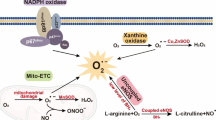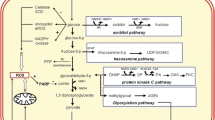Abstract
Objective
Metformin may influence atherogenesis but the mechanisms are not well understood. A pilot study was undertaken to determine whether metformin administration is associated with changes in oxidative stress and endothelial function.
Methods
Fifteen type 2 diabetic patients were treated for 3 months with metformin (1,700 mg daily) or with a placebo in a crossover study. Laboratory parameters of oxidative stress, fibrinolysis and endothelial function were evaluated both prior to and following the respective treatments. In addition, laser Doppler was used to determine microcirculation changes in the skin.
Results
Increases in serum N-acetyl-β-glucosaminidase activity (p < 0.05) and plasma malondialdehyde concentration were found following 1 month of metformin administration. Three months of treatment was accompanied by significantly increased plasma malondialdehyde (p < 0.001) and ascorbic acid (p < 0.01) concentrations as well as the alpha-tocopherol/(cholesterol + triglyceride) ratio (p < 0.001). The concentration of tissue plasminogen activator (tPA), vascular cell-adhesion molecules (VCAM) and intercellular cell-adhesion molecules (ICAM) were significantly decreased (p < 0.01) compared with placebo. Microcirculation measured by laser Doppler flowmetry was not significantly changed.
Conclusions
We conclude that initiation of metformin treatment in type 2 diabetic patients is associated with improved diabetes control as well as with activation of oxidative stress together with antioxidant system. The atherogenic process measured by biochemical indicators is diminished in parallel. Our results show that in short-term metformin administration in type 2 diabetes promotes endothelium effects associated with a complex of metabolic changes.


Similar content being viewed by others
References
Nedeljkovic ZS, Gokce N, Loscalzo J (2003) Mechanisms of oxidative stress and vascular dysfunction. Postgrad Med J 79:195–200
Tomiyama H, Kushiro T, Okazaki R, Yoshida H, Doba N, Yamashina A (2003) Influences of increased oxidative stress on endothelial function, platelets function, and fibrinolysis in hypertension associated with glucose intolerance. Hypertension Res 26:295–300
Evans M, Anderson RA, Graham J et al (2000) Ciprofibrate therapy improves endothelial function and reduces postprandial lipemia and oxidative stress in type 2 diabetes mellitus. Circulation 101:1773–1779
Wassmann S, Nickenig G (2003) Interrelationship of free oxygen radicals and endothelial dysfunction-modulation by statins. Endothelium 10:23–33
Woodman RJ, Chew GT, Watts GF (2005) Mechanisms, significance and treatment of vascular dysfunction in type 2 diabetes mellitus-focus on lipid-regulating therapy. Drugs 65:31–74
Ceriello A (2003) The possible role of postprandial hyperglycemia in the pathogenesis of diabetic complications. Diabetologia 46(Suppl 1):M9–M16
Schram MT, Chaturvedi N, Schalkwijk C et al (2003) Vascular risk factors and markers of endothelial function as determinants of inflammatory markers in type 1 diabetes-The EURODIAB prospective complications study. Diabetes Care 26:2165–2173
Mather KJ, Verma S, Anderson TJ (2001) Improved endothelial function with metformin in type 2 diabetes mellitus. J Am Coll Cardiol 37:1344–1350
Jennings PE, Belch JJF (2000) Free radical scavenging activity of sulphonylureas: A clinical assessment of the effect of gliclazide. Metabolism-Clinical and Experimental 49(Suppl 1):23–26
Shimabukuro M, Higa N, Takasu N (2006) Comparison of the antioxidant and vascular effects of gliclazide and glibenclamide in type 2 diabetic patients-A randomized crossover study. J Diab Compl 20:179–183
Ouslimani N, Peynet J, Bonnefont-Rousselot D, Therond P, Legrand A, Beaudeux JL (2005) Metformin decreases intracellular production of reactive oxygen species in aortic endothelial cells. Metabolism 54:829–834
Hattori Y, Suzuki K, Hattori S, Kasai K (2006) Metformin inhibits cytokine-induced nuclear factor kappa B activation via AMP-activated protein kinase activation in vascular endothelial cells. Hypertension 47:1183–1188
Detaille D, Guigas B, Chauvin Ch et al (2005) Metformin prevents high-glucose-induced endothelial cell death through a mitochondrial permeability transition-dependent process. Diabetes 54:2179–2187
Bradley JD, Zhonglin Y, Benoit V, Ming-Hui Z (2006) Activation of the AMP-activated kinase by antidiabetes drug metformin stimulates nitric oxide synthesis in vivo by promoting the association of heat shock protein 90 and endothelial nitric oxide synthase. Diabetes 55:496–505
Majithiya JB, Balaraman R (2006) Metformin reduces blood pressure and restores endothelial function in aorta of streptozotocin-induced diabetic rats. Life Sci 78:2615–2624
Kraemer de Aguiar LG, Bahia RL, Villela N et al (2006) Metformin improves endothelial vascular reactivity in first-degree relatives of type 2 diabetic patients with metabolic syndrome and normal glucose tolerance. Diabetes Care 29:1083–1089
Yagi H (1976) A simple fluorometric assay for lipoperoxide in blood plasma. Biochem Med 15:212–216
McCord JM, Fridovich I (1969) Superoxide dismutase. J Biol Chem 244:6049–6055
Nakagawa K, Kanno H, Miura Y (1997) Detection and analyses of ascorbyl radical in cerebrospinal fluid and serum of acute lymphoblastic leukemia. Anal Biochem 254:31–35
Catignani GL (1986) An HPLC method for the simultaneous determination of retinol and alpha-tocopherol in plasma or serum. Methods Enzymol 123:215–219
Henle T, Deppisch R, Beck W, Hergesell O, Hansch G, Ritz E (1999) Advanced glycation endproducts (AGE) during haemodialysis treatment: discrepant results with different methodologies reflecting the heterogeneity of AGE compound. Nephrol Dial Transplant 14:1968–1975
Munch G, Kies R, Wessel A et al (1997) Determination of advanced glycation end products in serum by fluorescence spectroscopy and competitive ELISA. Eur J Clin Chem Clin Biochem 35:669–677
Witko-Sarsat V, Friedlander M, Capeillere-Blandin C et al (1996) Advanced oxidation protein products as a novel marker of oxidative stress in uremia. Kidney Int 49:1304–1313
Škrha J, Perušičová J, Štolba P, Stibor V, Páv J (1987) Comparison of N-acetyl-β-glucosaminidase and albuminuria with clinical finding of microangiopathy in type 1 diabetes mellitus. Clin Chim Acta 166:135–141
Matthews DR, Hosker JP, Rudenski AS, Naylor BA, Treacher DF, Turner RC (1985) Homeostasis model assessment: insulin resistance and β-cell function from fasting plasma glucose and insulin concentrations in man. Diabetologia 28:412–419
Škrha J, Prázný M, Haas T, Kvasnička J, Kalvodová B (2001) Comparison of laser-Doppler flowmetry with biochemical indicators of endothelial dysfunction related to early microangiopathy in type 1 diabetic patients. J Diab Compl 15:234–240
Škrha J, Hilgertová J (1999) Relationship of serum N-acetyl-β-glucosaminidase activity to oxidative stress in diabetes mellitus. Clin Chim Acta 282:167–174
Bellin C, de Wizza DH, Wierensperger NF, Rosen P (2006) Generation of reactive oxygen species by endothelial and smooth muscle cells: Influence of hyperglycemia and metformin. Horm Metab Res 38:732–739
Rosen P, Wierensperger NF (2006) Metformin delays the manifestation of diabetes and vascular dysfunction in Goto-Kakizaki rats by reduction of mitochondrial oxidative stress. Diabetes-Metabol Res Rev 22:323–330
Charles MA, Morange P, Eschwege E, Andre P, Vague P, Juhan-Vague I (1998) Effect of weight change and metformin on fibrinolysis and the von Willebrand factor in obese nondiabetic subjects-The BIGPRO1 study. Diabetes Care 21:1967–1972
Katakam PVG, Ujhelyi MR, Hoenig M, Miller AW (2000) Metformin improves vascular function in insulin-resistant rats. Hypertension 35:108–112
Acknowledgement
The authors are indebted to Marcela Jarolímková, Hana Homolková and Jana Mrázková for technical assistance. We thank Dr. Nicolas Wierensperger for valuable discussion. The study was supported by the Research Project MSM0021620807 of the Ministery of Education and by Merck Santé.
Author information
Authors and Affiliations
Corresponding author
Rights and permissions
About this article
Cite this article
Škrha, J., Prázný, M., Hilgertová, J. et al. Oxidative stress and endothelium influenced by metformin in type 2 diabetes mellitus. Eur J Clin Pharmacol 63, 1107–1114 (2007). https://doi.org/10.1007/s00228-007-0378-1
Received:
Accepted:
Published:
Issue Date:
DOI: https://doi.org/10.1007/s00228-007-0378-1




